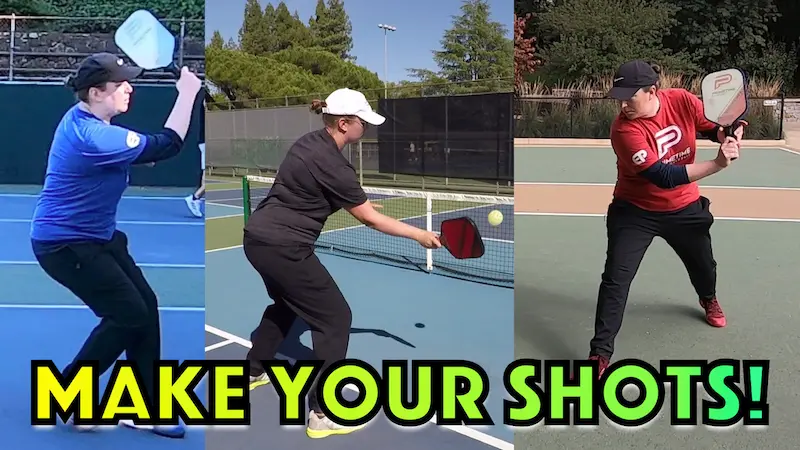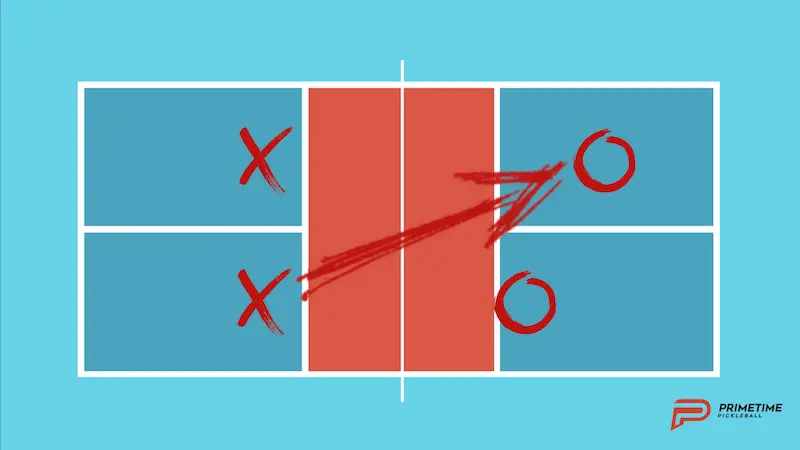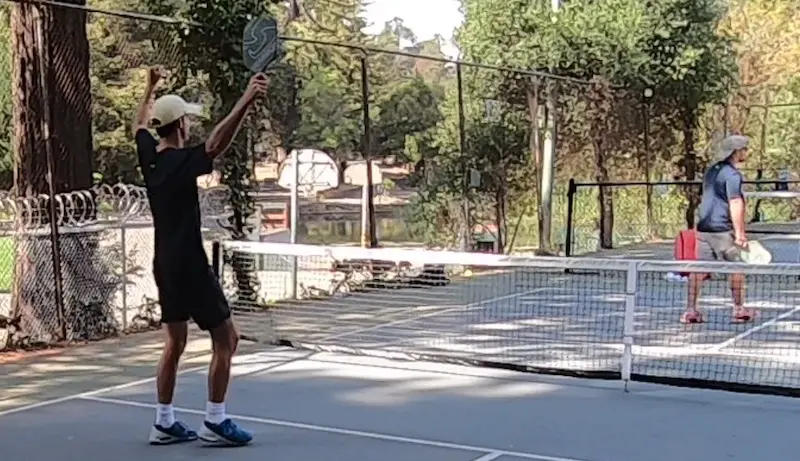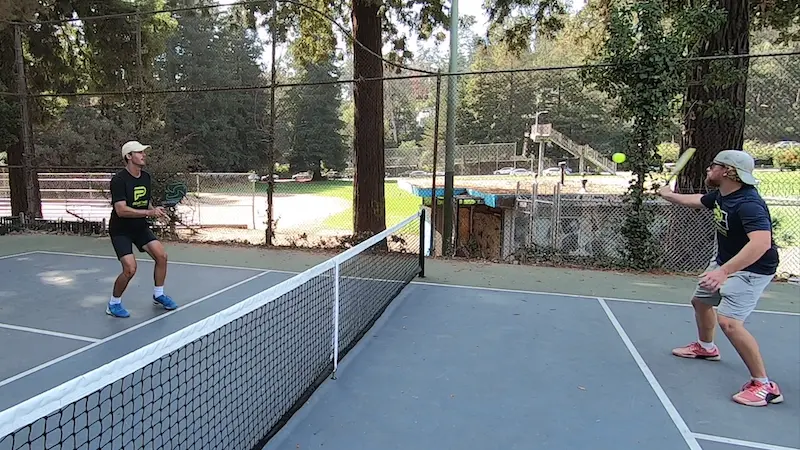We’re going to cover what I consider to be the Five Golden Rules of Pickleball. Now these are NOT the basic rules of pickleball such as:
- What shots are in vs. out
- What are the boundaries of the court?
- How do I start the point?
- How do I score?
- When do we switch sides?
- Etc…
These are the Golden Rules of Pickleball if you want to be out there playing your best game. In order to have a chance at playing your best game each and every time you step out on to the court, you’re going to have to apply these principles…every time! And against the better teams, you’re going to need to be at your best so that you give yourself the best chance of winning.
Golden Pickleball Rule #1 – Fully Engage Your Body
Now what does it mean to have your body full engaged when you play? It means that you need to move your feet, split step, have good footwork getting to the ball, but also have good footwork between when you’re hitting the ball and the next time you hit the ball. This is also know as recovery footwork.
Another key component of having your body fully engaged is have your eyes watching the ball as much as you can. That is relatively easily done from the baseline when you have quite a bit of time because you’re sending the ball quite a distance and it’s also coming back from more of a distance.
Even if they’re up at the net and your back, you do have time to more or less watch the ball almost all the way into your paddle and coming off. You can’t every really fully see contact because that’s happening too quickly for the eye to see but you can watch it coming all the way in to contact and going out.
When you’re at the net that’s a bit of a different story. You still want to try to watch the ball as much as possible so it’s advisable to work on your eye tracking speed but you are going to have to rely more on your peripheral vision to track your contact in quick shoot outs at the net. In fast exchanges, your eyes will have to be more focused on tracking between your opponents contact and a few feet away from you so that you can see the change of direction your opponent is making to the ball in order to be able to react to it. Perfect tracking all the way into your paddle will have to suffer as a result.
If you’re dinking or dealing with any kind of a slower incoming shot the you will have time to watch the ball more closely and anytime you can do that, you should!
Last but certainly not least when it comes to having your body fully engaged is that you want to breathe. But you have to breathe in a specific way.
Generally speaking, when you’re loading up for your shot and getting yourself set with your take back, that’s when you’re going to be inhaling. As you swing and release your shot you’re, that’s when you’re going to be exhaling. You want to be doing that on every shot. Of course you may need to breathe in between shots but the rhythm as you’re hitting should be inhale to prepare, exhale to strike.
Golden Pickleball Rule #2 – Consistency!

You have to make your shots in order to win points. There’s really no way around that so it’s better to sacrifice a little bit of power for the sake of making the shot. My advice to many players is to take 15-25% of power off your shots and make them more often than not. I find that too many players are playing at a level of power just outside their ability to control it. We all like to push the envelope a bit right? Resist the urge to do this and you’ll likely find yourself winning more points as a result.
Along with taking a little bit of pace off the ball, you may also want to give yourself more buffer from the lines. Depending on how accurate you are you may need more or less buffer but you never really want to be aiming directly for the line. You want to give yourself a little bit of cushion and margin for error from the lines and also from the net. Clear the net by a few inches at least, don’t just be scraping by on everything.
The more accurate you are, the less buffer you need. All the shots you’re going for should be well within your skill set so you should be relatively confident that you can make that shot nine out of ten times. If you’re only going to make the shot that you’re going for three out of ten times or even four or five out of ten then you simply can’t be going for that shot. It’s a losing proposition over time. Play within your skill set.
You can widen the range of the shots you can go for by improving your skill set. If you want to hit closer to the lines and with more power…fine! Work on it so that your skill lives up to that desire. There is so much you can do to shore up your weaknesses and make your strengths into weapons.
If you plan some time to practice, as you should be doing frequently, you’ll want to dividi that time in a smart way so you can get the most out of it. Spend the first two thirds or so of that time stabilizing the shots that you’re not so good. Spend the last third of your practice time working on your favorite shots, your weapons so that you can develop those weapons into a devastating force that will wreak havoc on the courts.
Obviously you need to be working both your weaknesses and your strengths. What I propose here is a nice way to divide your time because you’re a bit fresher at the beginning of practice and that will give you more mental and physical bandwidth to deal with the challenge and frustration that can and will come up as you develop areas of your game that you’re not as good at. Then, towards then you essentially get to treat yourself to the gift of getting to “play” with your favorite shots.
The key take away in all of this is to remember that when you’re out there playing you, must make your shots! The team that doesn’t make their shots doesn’t win the team. The team that makes their shots wins. It can often really be that simple. So, it’s better to keep the ball in the court and have an average shot rather than go for that fancy shot and be missing it every other time.
Golden Pickleball Rule #3 – Have A Plan For Each Shot & Point!

I often see players just hit the serve or get the return back and apply a “wait and see” approach to the rest of the point. In fact, I’ve had player’s literally tell me that is what they do. What they’re saying without realizing it is that they are playing reactionary pickleball. When you’re relying on reactions and responding to what you get, you’re not in charge. It’s like being on defense the entire point. It’s not a smart way to approach playing if your goal is to win.
You always want to have a plan when you step out onto the court. You want to be proactive rather than reactive. Go out there with an idea as to what you’re going do with each type shot you expect to receive.
You want to think: “when they come here and I get this shot, I’m going to do this. If they go here and I get this type of shot, I’m going to do that.” And if your original plan is working…. great! Keep going with that plan, If it’s not working then read and adjust to the situation and give them shots that they don’t like to hit while trying to set yourself up to receive shots that you like to hit.
You always want to be intentional and impose your will on your opponents. Don’t just go out there and say “I’m going to see what happens and hope I can react well and it will all work out for the best.”
Have a purpose and have an idea as to what you want to do so that you can build your points and stack up towards the win because if you don’t do that you’re just going to be responding to what your opponents have decided to do to you. That’s not generally a good idea because you’re basically going to be reactionary and on defense the whole time and that’s not what you want. You want to be dictating and be on offense and imposing yourself and your strengths onto their weaknesses.
Golden Pickleball Rule #4 – Be & Stay Positive!

It is so vital to stay positive with yourself in singles and in doubles and with yourself and your partner in doubles. This is so very important and all the other golden rules and really your entire pickleball game hinges on this.
Stay positive and be encouraging with yourself and your partner when you do something good. Give yourself props for that. If your partner does good things, let them know. Say things like “hey, awesome shot!” Or “Good playing, let’s keep it up”. Say things that are encouraging. That’s relatively easy to do because you’re feeling good about what’s happening and it’s a good idea to point that out in words. It strengthens your connection.
What goes hand in hand with that yet is not necessarily as easy to do but must be done is to be encouraging towards yourself and towards your partner especially when you’re struggling. When you’re struggling, be your own biggest fan and cheerleader. If you missed an easy shot, no worries. Tell yourself “let’s go, next one point”.
If you’re in a bit of a lull and you’ve played two or three not so great points, do a little bit of jumping up and down. Get yourself energized and pump yourself up with more encouraging words like “We got this, here we go.” If your partner misses a shot you can say “hey, no worries, let’s go here, we got this on the next one”. If they barely missed it but they went for the right shot you can say “good idea, you’ll get it on the next one”.
Stay positive and take responsibility for your own emotional state out there. Everyone loves to play with a positive person. Everyone hates to play with a negative person. Be a positive person in good times and bad. That will take you so far and it will pull you out of so many slumps. It really pays dividends when you’re positive especially when you’re going through tough times. It can, and does, and often will pull you out of an undesirable slump.
It’s a key ingredient towards giving yourself and your team a chance to turn things around and ultimately squeak out a win that looked like it probably wasn’t going to happen. And it is “oh so sweet…” when you’re able pull yourself and your partner as a team out of it and then ultimately win even if you had a rough patch there somewhere in the middle.
Your mental state and attitude has such a huge impact on your play and that of your team. Now, are you always going to be able to turn it around and come out of a bad playing patch with the win every time. No, certainly not, but you definitely give yourself the best opportunity to do so.
You are not always going to win. That should be very clear to you if you’ve ever played any sport or game. You may or may not be the best skilled player or team out there but what you can do more often than not is play really well even if you end up losing. Your attitude and positivity will go a long way towards helping you do that. Even if you come away with the “L” as opposed to the “W”, you can be proud of how you performed and played.
Golden Pickleball Rule #5 – Be Ready For The Drive First!

Always be ready for that hard hit shot FIRST because that one is the most likely to hurt you. It can jam/handcuff you or get by you. You always have a chance at these dealing with these shots but it’s usually going to be tough.
If you weren’t ready then you’re going to have a hard time having your hands react fast enough to block or counterattack. You also won’t give yourself a chance to get moving fast enough to get it on the stretch.
You need to split step in anticipation for a hard shot to come. If a soft one comes, such as a dink or drop, that’s great, chances are you will have plenty of time to deal with it. The exception to that is if you’re way back behind the baseline and it’s a very well hit drop shot. Yes, those do happen but percentage-wise they don’t happen that often overall. You’re far more likely to get hurt by a hard drive so be ready for that to come at any time. You should assume that’s coming so that you’re ready in case it does.
If you see that your opponent has any chance at all to drive then what you typically want to do is get in the middle of their most likely range of shot options. If you happen to know what their tendencies are then get in the middle of their likely tendencies.
Always seek to get in the middle of the highest percentage shots that they are most likely to hit based on where they are in the court and what the range of shot trajectories available to them are.
Usually players are building up the point towards an opportunity to drive and end the point. It’s best to always be ready for that drive first in order to prevent that since that has the highest chance of winning the point for them if they’re able to jam you up or pass you.
In Conclusion
Know these 5 Golden Rules, use them in your play at all times, and you will be a force to be reckoned with anytime you step on the court.